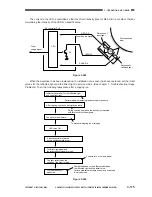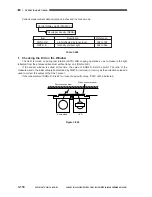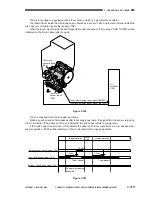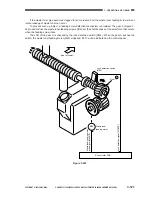
COPYRIGHT © 2001 CANON INC. CANON CLC1000/1000S/3100 REV.2 MAY 2001 PRINTED IN JAPAN (IMPRIME AU JAPON)
3-107
3. OPERATION AND TIMING
4. Supplying Toner
a.
Outline
Toner is supplied from the hopper based on the measurements taken of the toner density. Different
methods are used to measure the density between Bk toner and Y, M, and C toners because of different
toner characteristics. For Y, M, and C toners, the color toner density sensor is used to measure the density
of the toner in the developer layer on the developing cylinder. As in the case of carriers, the Bk toner tends to
absorb infrared light, and for this reason the density on the developing cylinder cannot be measured. The
video signals carrying a Bk component are counted to find out the image density, thereby computing toner
consumption. When copying operation ends, the SALT sensor measures the toner image on the
photosensitive drum to find out the toner density.
Figure 3-532
See Figures 3-533 and -534 for sequences used to measure Y, M, and C toners and the Bk toner; the
supply operation is executed each time the measurement value falls below a specific value.
Measuring the Y, M, and C Toners
Measuring the Bk Toner
Figure 3-533
Figure 3-534
Photosensitive
drum
Developing cylinder
SALT sensor
Color toner density sensor
Hopper
Image density detection
DC controller PCB
Start key ON
1st copy
2nd copy
End
Detects the density of toner on the developing
cylinder (color toner density sensor)
Detects the density of toner on the developing
cylinder (color toner density sensor)
Detects the density of toner
on the drum (SALT sensor)
Start key ON
1st copy
2nd copy
End
Image density detection
Detects the density of toner
on the drum (SALT sensor)
Image density detection
Summary of Contents for 1000S
Page 12: ......
Page 30: ......
Page 44: ......
Page 86: ......
Page 254: ......
Page 372: ......
Page 374: ......
Page 418: ......
Page 438: ......
Page 442: ......
Page 754: ......
Page 764: ......
Page 766: ......
Page 840: ...0501GR PRINTED IN JAPAN IMPRIME AU JAPON This publication is printed on 100 reprocessed paper ...

































